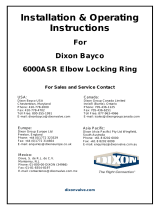Page is loading ...

40234PA AUGUST 2008
1
INSTALLATION INSTRUCTIONS
For
DIXON DBCL SERIES DRY DISCONNECT
LEVER LATCH
Model Numbers
For Sales & Service Contact
Dixon Bayco
A DIXON COMPANY
U S A: Dixon Bayco Limited
Dixon Bayco USA
Chestertown, Maryland
Phone: 410-778-2000
Fax: 410-778-4702
Toll Free: 800-355-1991
CANADA:
Dixon Bayco Limited
Barrie, Ontario
Phone: 705-436-1125
Fax: 705-436-6251
Toll Free: 800-355-1991
DBCL-200 ......... Lever Latch for 1.5” & 2” Dry Disconnect Couplers
DBCL-300 ......... Lever Latch for 3” Dry Disconnect Couplers

40234PA 2 AUGUST 2008
FIGURE 1

40234PA 3 AUGUST 2008
FIGURE 2

40234PA 4 AUGUST 2008
INSTALLATION INSTRUCTIONS:
WARNING: When assembling or disassembling these products, always
wear safety glasses. Severe eye injury may result if not wearing safety
glasses.
1. Remove the pin as indicated in figure 1 using a punch and hammer. This pin has 3 ‘barbs’
on one end for retention. Be sure to strike the pin on the end that does not contain the
‘barbs’ or it will be far more difficult to remove the pin.
2. Insert the clevis pin contained in the kit through the hole in the lever where you just removed
the ‘barbed’ pin. The pin should slide through freely without binding or excessive force. If it
does not, follow steps a-c below.
a. Sometimes the clevis pin will not slide freely through the lever hole. This can be
caused by metal burrs remaining in the hole or a slight curvature of the hole caused
by the clamping action of the lever bolt.
b. If the clevis pin cannot be inserted through the hole in the lever, use a #12 (0.189”)
drill bit (or preferably a 3/16” reamer) and a hand drill to clean out the hole.
c. Run the reamer or drill through the hole until the clevis pin can be inserted freely.
3. Once the clevis pin has been verified to freely go through the hole in the lever, the latch
assembly can be installed.
4. With the clevis pin removed from the hole in the lever, insert the compression spring in the
pocket on the underside of the latch assembly.
5. Using you finger to hold the compression spring in place, place the latch assembly over the
lever and push down on the latch assembly to compress the spring.
6. While compressing the spring, align the hole in the latch assembly with the hole in the lever
and insert the clevis pin through the latch assembly and lever.
7. Verify that the latch assembly is free to move on the clevis pin
8. Secure the clevis pin with the cotter pin supplied.
The latch assembly is actuated by depressing the lock plate on the top and then rocking the latch
assembly such that the legs clear the cast stops on the body.
DIXON BAYCO WARRANTY:
For Warranty Information, please refer to the inside back cover of the latest Dixon
Catalog.

40234PA AUGUST 2008
1
INSTRUCTION D’INSTALLATION
pour
RACCORDS RAPIDES POUR TRANSFÈRE
SÉCURISÉ SÉRIE DBCL DIXON
LOQUET POUR LEVIER
DBCL-200 Loquet de levier pour coupleur à raccords rapides pour transfère sécurisé de 1.5” &2”
DBCL-300 Loquet de levier pour coupleur à raccords rapides pour transfère sécurisé de 3”
E-U:
Dixon Bayco USA
Chestertown, Maryland
Téléphone : 410-778-2000
Fax: 410-778-4702
Sans frais: 800-355-1991
E-mail: dixonbayco@dixonvalve.com
www.dixonbayco.com
Canada:
Dixon Group Canada Limited
Innisfil (Barrie), Ontario
Téléphone: 705-436-1125
Fax: 705-436-6251
Sans frais: 877-963-4966
E-mail: isales@dixongroupcanada.com
www.dixongroupcanada.com
Mexique:
Dixva, S. de R.L. de C.V.
Monterrey, N.L
Téléphone: 01-800-00-DIXON (34966)
Fax: 01-81-8354-8197
E-mail :contactenos@dixonvalve.com.mx
www.dixonvalve.com
Europe:
Dixon Group Europe Ltd
Preston, England
Téléphone +44 (0)1772 323529
Fax: +44 (0)1772 314664
E-mail: enquiries@dixoneurope.co.uk
www.dixoneurope.co.uk
Asie et Pacifique:
Dixon (Asia Pacific) Pty Ltd
Wingfield, South Australia
Téléphone +61 8 8202 6000
Fax: +61 8 8202 6099
E-mail:[email protected].au
www.dixonvalve.com.au
Pour vente & service contactez

40234PA(fr)
FIGURE 1

40234PA(fr)
FIGURE 2

40234PA(fr)
INSTRUCTION D’INSTALLATION:
AVERTISSEMENT: Lorsque vous assemblez ou désassemblez ces
produits, portez toujours des lunettes de sécurités. Des accidents
sévères pourraient en résulter si vous ne portez vos lunettes de
sécurités.
1. Retirez la goupille comme indiquer sur la figure 1 en utilisant un marteau et un poinçon.
Cette goupille a 3 barbelures sur une extrémité pour une bonne rétention. Assurez-vous de
frappez la goupille sur l’extrémité qui n’a pas de barbelure sinon il sera difficile de retirer la
goupille.
2. Insérez l’axe à l’épaulement dans la trousse à travers le trou du levier ou la goupille
barbelée a été retirée. Elle devrait glisser librement sans restriction ou sans utiliser une
force excessive. Sinon, utilisez-les pas de A à C ci-dessous.
a. Parfois l’axe à l’épaulement ne glissera pas librement à travers le trou du levier. Cela
peut être causé pas des bavures de métal dans le trou ou une légère courbure du
trou causé par l’action de serrage de la vis du levier.
b. Si l’axe de l’épaulement ne peut pas être insérez dans le petit trou, utilisez un foret
#12 (0.189”) (ou préférablement une fraise de 3/16”) et une perceuse pour nettoyer le
trou.
c. Activez la fraise ou percez à travers le trou jusqu’à ce que la goupille de chape
puisse être insérer librement.
3. Une fois que l’axe à l’épaulement ait été vérifié pour un mouvement libre à travers du trou
du levier, l’assemblée du loquet peut être installée.
4. Avec l’axe à l’épaulement hors du trou du levier, insérez le ressort de compression dans la
poche sous l’assemblé du loquet.
5. En utilisant votre doigt retenez le ressort de compression en place, placez l’assemblée du
loquet au dessus du levier et appuyez sur l’assemblée du loquet pour compresser le ressort.
6. En compressant le ressort, alignez le trou sur l’assemblée du loquet avec le trou du levier et
insérez l’axe à l’épaulement dans l’assemblée du loquet et du levier.
7. Vérifiez que l’assemblée du loquet ait un mouvement libre sur l’axe à l’épaulement.
8. Sécurisez l’axe à l’épaulement avec la goupille rainurée fournie.
L’assemblée du loquet est actionnée en appuyant sur la plaque de verrouillage sur le dessus puis
en faisant tourner le loquet de façon que les jambes soient claires du moulage d’arrêt de la pièce.
GARANTIE DIXON
Pour plus d’informations complètes sur la garantie, s’il vous plait se référer à la
couverture intérieure de la dernière page du dernier catalogue Dixon.
/







